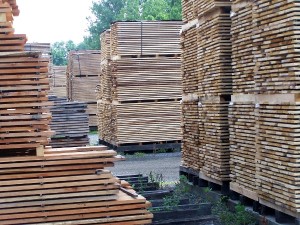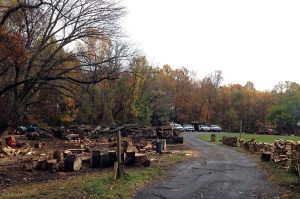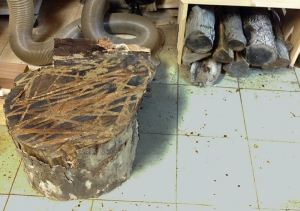The Wood is Always Greener on the Other Side of the Fence
 3 years ago when I started working for a lumber company, I wondered if the towering stacks of hardwoods from all over the world would cease to impress me over time. Would I become jaded and take this bounty for granted? I’m pleased to say that this hasn’t happened one bit. I still get a thrill coming into work each day and perk up a little each time a new tractor trailer pulls into the yard filled with new material. This time of year is like Christmas for many reasons since most rainy season prone countries do all their shipping during our Fall and Winter. Each day there is at least one new container rolling into the yard to tear the paper off and ooh and aah over the presents inside.
3 years ago when I started working for a lumber company, I wondered if the towering stacks of hardwoods from all over the world would cease to impress me over time. Would I become jaded and take this bounty for granted? I’m pleased to say that this hasn’t happened one bit. I still get a thrill coming into work each day and perk up a little each time a new tractor trailer pulls into the yard filled with new material. This time of year is like Christmas for many reasons since most rainy season prone countries do all their shipping during our Fall and Winter. Each day there is at least one new container rolling into the yard to tear the paper off and ooh and aah over the presents inside.
I have easy access to some incredible lumber here, but it is all kiln dried and limited to commercially in demand species. What is that expression about the grass being greener on the other side of the fence? It seems that I’m a bit guilty of that. Y’see lately I have had a taste of working with air dried and green lumber. For a hand tool woodworker this is a revelation. No more baked and hardened fibers from the kiln and green wood that works the same as a piece of hard cheese. Wood that ejects long shavings from the pole and flywheel lathes with ease is pretty compelling as any urban lumber hunting bowl turner can attest. So it is with some kind of cosmic irony that I sit day in and day out surrounded by beautiful lumber and yet still yearn for something else. Something that literally is greener and literally is on the other side of the fence.
So off I go to the local tree service company to hunt for some material for bowls and spindle work for some upcoming lessons I’m filming. The first time I did this years ago was after I built my first Windsor chair and I was totally hooked on the the green woodworking idea. It is a very difference experience from the lumber yard but something that every woodworker should experience. What could be cooler than going one step closer to the living tree and looking for wood in log form? Moreover with smaller turned projects, you can get away with using a lot more of the tree from branch wood to stump and saddle. Then there are the species available to you. I walked onto the yard of a new place I drive by a lot yesterday called Myers Tree Service. Immediately I was surrounded by logs of Sycamore, Paulownia, Catalpa, Apple, Hickory, Elm, Chinese Elm, Osage Orange, Plum, Pear, and every minor species variation of Cherry, Walnut, Maple, and Oak. This was just in the first 20 feet of the yard!
I struck up a conversation with the owner, Bill and we hit is off immediately. Bill isn’t a woodworker but an arborist who loves wood probably more than I do. Bill took me all over his yard showing off his logs like a proud father and all the while my creative juices were flowing. As we walked by log after log of Hickory, Ash, and Oak, I began to see my next few Windsor chairs. We turned down the fruitwood lane and visions of tool handles and hand planes began to pop up. These were all whole logs, some of which exceeded 4 feet in diameter.
Then there was what Bill called his “chunk wood”. As a tree service company they take the whole thing and use every last bit of it. The branches are trimmed and split for firewood and BBQ enthusiasts. The crotches, stumps, saddles, and any interesting grain pieces are left for wood turners. Bill even had a whole section set aside of unusual looking pieces used by several of his furniture making customers who make natural form outdoor furniture leaving as much of the tree intact. It was heartening to see what happens to those trees you see being cut down in your neighborhood or alongside the road by the power lines. I was in heaven and began to think about what I wanted for my next few projects.
$15 later I had had loaded up my car with Apple, Walnut, Sycamore, Hickory, Plum, Cherry, Maple, and Hornbeam logs all about 20″ long and 6-8″ in diameter. Yes you read that right, $15. I always keep my eye open for wood in my neighborhood but more often than not my neighbors hire a tree service like Bill to take down the tree and usually Bill takes all the lumber with him. So while I’m not able to get it for free, I am able to support a local business and end up with a much wider variety of species than if I grabbed wood from a neighbors yard. Truly even if I had just gone and bought some firewood from Bill I could have been set for the turning projects I’m about to start.
So it seems that my definition of “lumber yard” has changed. What many of you consider the lumber yard, I think of as “the office” and now my lumber yard is a muddy lot filled with all manner of logs and a band mill. You can guarantee I’ll be back to take advantage of that mill and some of those larger logs.




